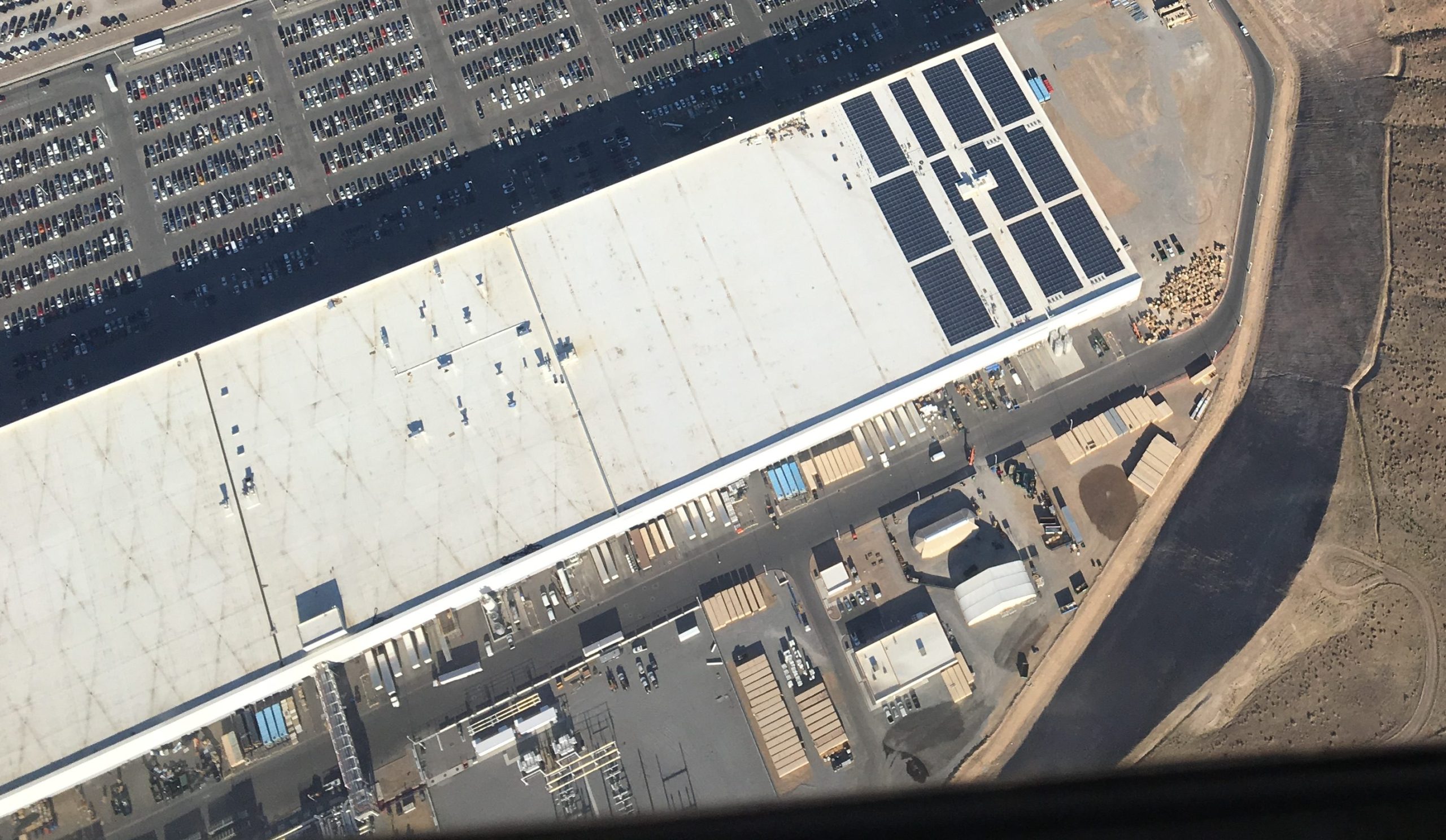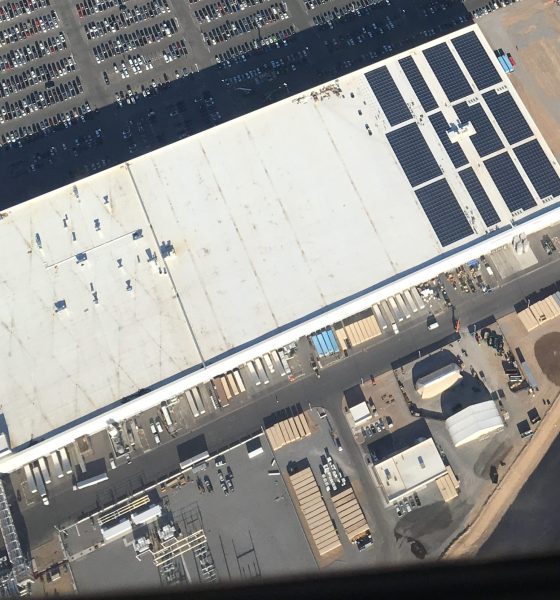

News
Tesla Gigafactory 1’s rooftop array expands with new solar panel clusters
Tesla’s Gigafactory in Nevada has always been intended to be powered entirely by renewable energy. Aerial images of the facility taken earlier this year revealed that the company began installing several clusters of solar panels on the factory’s roof, though construction of the solar arrays was halted after the sixth cluster was completed. That said, Tesla appears to have resumed work on Gigafactory 1’s rooftop solar array, adding six new clusters to the roof of the sprawling facility recently.
Teslarati recently obtained aerial images of the new rooftop solar panel clusters being installed in Gigafactory 1. Continuing from the work started earlier this year, the new clusters of solar panels are installed on the north end of the facility. Images of the recently built parking lot north of Gigafactory 1 also show a number of containers and semi-trailers.
- Aerial images of the Tesla Gigafactory as of August 28, 2018. [Credit: Joshua Mcdonald]
- Aerial images of the Tesla Gigafactory as of August 28, 2018. [Credit: Joshua Mcdonald]
Aerial images of the Tesla Gigafactory as of August 28, 2018. [Credit: Joshua Mcdonald]
Gigafactory 1 is designed to feature an expansive 70 MW solar array on its roof. A handout of the facility given to guests at a previous investor event stated that Gigafactory 1’s solar array would likely be the largest rooftop installation in the world, particularly when the planned 13-million-square-foot facility is completed.
“GF1 is an all-electric factory with no fossil fuels (natural gas or petroleum) directly consumed. We will be using 100% sustainable energy through a combination of a 70 MW solar rooftop array and solar ground installations. The solar rooftop array is ~7x larger than the largest rooftop solar system installed today,” Tesla’s handout read.
Elon Musk recently provided an update on Gigafactory 1’s transition to fully renewable energy, stating in a recent tweet that the facility will be 100% renewable and powered by Tesla Solar at the end of 2019. This aggressive timeline is classic Musk, and it was released roughly at the same time as work on the facility’s rooftop solar array resumed.
This is utterly false. Fossil fuel merchants of doubt have been pushing that bs for years. Tesla Gigafactory will be 100% renewable powered (by Tesla Solar) by end of next year.
— Elon Musk (@elonmusk) August 25, 2018
As impressive as the Nevada Gigafactory is today, the facility is actually still less than 30% complete. Gigafactory 1 currently has a 1.9 million square foot footprint, with roughly 4.9 million square feet of operational space across several floors. The footprint of the building itself has not changed over the past two years either, as the company has largely focused on growing and optimizing the facility from within since the Model 3 ramp took center stage.
That said, signs are emerging that Tesla might be looking to expand Gigafactory 1’s physical footprint soon. The construction of the new parking lot north of the factory, for one, suggests that the company might be making way for some construction work west of the facility, which happens to be a parking lot used by employees today.
Gigafactory 1 is one of Tesla’s most pivotal facilities. Tasked with the production of battery packs and powertrains for the Model 3, Gigafactory is responsible for ensuring that Tesla meets the demand for the electric sedan. Late last month, Panasonic, Tesla’s battery partner, also noted that it would be increasing its manufacturing capacity by 30% to address the increasing demand for batteries caused by the Model 3 ramp. According to a report from 103-year-old Japanese news agency Nikkan Kogyo, Panasonic will be adding three new cell production lines for lithium-ion batteries in Gigafactory 1 at the “end of 2018.”

News
Tesla FSD fleet is nearing 7 billion total miles, including 2.5 billion city miles
As can be seen on Tesla’s official FSD webpage, vehicles equipped with the system have now navigated over 6.99 billion miles.

Tesla’s Full Self-Driving (Supervised) fleet is closing in on almost 7 billion total miles driven, as per data posted by the company on its official FSD webpage.
These figures hint at the massive scale of data fueling Tesla’s rapid FSD improvements, which have been quite notable as of late.
FSD mileage milestones
As can be seen on Tesla’s official FSD webpage, vehicles equipped with the system have now navigated over 6.99 billion miles. Tesla owner and avid FSD tester Whole Mars Catalog also shared a screenshot indicating that from the nearly 7 billion miles traveled by the FSD fleet, more than 2.5 billion miles were driven inside cities.
City miles are particularly valuable for complex urban scenarios like unprotected turns, pedestrian interactions, and traffic lights. This is also the difference-maker for FSD, as only complex solutions, such as Waymo’s self-driving taxis, operate similarly on inner-city streets. And even then, incidents such as the San Francisco blackouts have proven challenging for sensor-rich vehicles like Waymos.
Tesla’s data edge
Tesla has a number of advantages in the autonomous vehicle sector, one of which is the size of its fleet and the number of vehicles training FSD on real-world roads. Tesla’s nearly 7 billion FSD miles then allow the company to roll out updates that make its vehicles behave like they are being driven by experienced drivers, even if they are operating on their own.
So notable are Tesla’s improvements to FSD that NVIDIA Director of Robotics Jim Fan, after experiencing FSD v14, noted that the system is the first AI that passes what he described as a “Physical Turing Test.”
“Despite knowing exactly how robot learning works, I still find it magical watching the steering wheel turn by itself. First it feels surreal, next it becomes routine. Then, like the smartphone, taking it away actively hurts. This is how humanity gets rewired and glued to god-like technologies,” Fan wrote in a post on X.
News
Tesla starts showing how FSD will change lives in Europe
Local officials tested the system on narrow country roads and were impressed by FSD’s smooth, human-like driving, with some calling the service a game-changer for everyday life in areas that are far from urban centers.

Tesla has launched Europe’s first public shuttle service using Full Self-Driving (Supervised) in the rural Eifelkreis Bitburg-Prüm region of Germany, demonstrating how the technology can restore independence and mobility for people who struggle with limited transport options.
Local officials tested the system on narrow country roads and were impressed by FSD’s smooth, human-like driving, with some calling the service a game-changer for everyday life in areas that are far from urban centers.
Officials see real impact on rural residents
Arzfeld Mayor Johannes Kuhl and District Administrator Andreas Kruppert personally tested the Tesla shuttle service. This allowed them to see just how well FSD navigated winding lanes and rural roads confidently. Kruppert said, “Autonomous driving sounds like science fiction to many, but we simply see here that it works totally well in rural regions too.” Kuhl, for his part, also noted that FSD “feels like a very experienced driver.”
The pilot complements the area’s “Citizen Bus” program, which provides on-demand rides for elderly residents who can no longer drive themselves. Tesla Europe shared a video of a demonstration of the service, highlighting how FSD gives people their freedom back, even in places where public transport is not as prevalent.
What the Ministry for Economic Affairs and Transport says
Rhineland-Palatinate’s Minister Daniela Schmitt supported the project, praising the collaboration that made this “first of its kind in Europe” possible. As per the ministry, the rural rollout for the service shows FSD’s potential beyond major cities, and it delivers tangible benefits like grocery runs, doctor visits, and social connections for isolated residents.
“Reliable and flexible mobility is especially vital in rural areas. With the launch of a shuttle service using self-driving vehicles (FSD supervised) by Tesla in the Eifelkreis Bitburg-Prüm, an innovative pilot project is now getting underway that complements local community bus services. It is the first project of its kind in Europe.
“The result is a real gain for rural mobility: greater accessibility, more flexibility and tangible benefits for everyday life. A strong signal for innovation, cooperation and future-oriented mobility beyond urban centers,” the ministry wrote in a LinkedIn post.
News
Tesla China quietly posts Robotaxi-related job listing
Tesla China is currently seeking a Low Voltage Electrical Engineer to work on circuit board design for the company’s autonomous vehicles.

Tesla has posted a new job listing in Shanghai explicitly tied to its Robotaxi program, fueling speculation that the company is preparing to launch its dedicated autonomous ride-hailing service in China.
As noted in the listing, Tesla China is currently seeking a Low Voltage Electrical Engineer to work on circuit board design for the company’s autonomous vehicles.
Robotaxi-specific role
The listing, which was shared on social media platform X by industry watcher @tslaming, suggested that Tesla China is looking to fill the role urgently. The job listing itself specifically mentions that the person hired for the role will be working on the Low Voltage Hardware team, which would design the circuit boards that would serve as the nervous system of the Robotaxi.
Key tasks for the role, as indicated in the job listing, include collaboration with PCB layout, firmware, mechanical, program management, and validation teams, among other responsibilities. The role is based in Shanghai.
China Robotaxi launch
China represents a massive potential market for robotaxis, with its dense urban centers and supportive policies in select cities. Tesla has limited permission to roll out FSD in the country, though despite this, its vehicles have been hailed as among the best in the market when it comes to autonomous features. So far, at least, it appears that China supports Tesla’s FSD and Robotaxi rollout.
This was hinted at in November, when Tesla brought the Cybercab to the 8th China International Import Expo (CIIE) in Shanghai, marking the first time that the autonomous two-seater was brought to the Asia-Pacific region. The vehicle, despite not having a release date in China, received a significant amount of interest among the event’s attendees.










